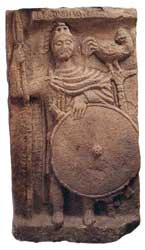 How soldiers’ fashions reflect political turmoil in Late Roman Britain
How soldiers’ fashions reflect political turmoil in Late Roman Britain
A Romano-British army in Spain. Anglo-Saxon mercenaries in eastern England. A great tribal confederation spanning south Britain. Stuart Laycock has been finding fresh evidence for the storm and strife at the end of Roman Britain in collections of buckles and belt-fittings.
Regional differences of style in Late Roman buckles and belt-fittings can be used to build a picture of political fragmentation in Britain in the years around AD 400 (CA 219). But they can tell other stories, too–of co-operation, collaboration, and conquest. In one case, we seem to have a group of Brits headed for Spain long before package holidays. In another, two polities on either side of England appear to buck the fragmentation trend with a long-distance love affair. And in a third, some of the earliest Anglo-Saxon settlers seem to have had a surprising taste in fashion accessories.
One of the most distinctive types of buckle from the late 4th and early 5th century in Britain is a type that carries two horse heads facing outwards on the top of the loop. A buckle plate from one was found in a Saxon cemetery at Westerwanna in northern Germany. Only two complete examples of these buckles have so far been identified in mainland Europe, however, and both have come from northern Spain, one from Iruña, the other from Barcelona.
This fact alone would be significant. But there are other links, too, between buckles and belt-fittings in Britain and those from northern Spain. Two propeller belt-stiffeners with specifically Spanish features have been found in Britain, even though they are very rare outside Spain. In addition, a dolphin buckle of distinctively British type was found on the same site as the Iruña horse-head buckle, and a dolphin buckle, probably of Spanish manufacture but inspired by British types, comes from Tirig. Moreover, from just north of the Spanish border at Argeliers in southern France comes another dolphin buckle, where the buckle plate is local but the buckle itself is of British type. Overall, links to British buckles and belt-fittings are very rare in mainland Europe, so this British-Spanish group is highly significant.
What does it mean? As with most distribution anomalies, different explanations are possible –the exchange of trade goods, the resettlement of migrants, the movement of soldiers. In this case, however, the historical sources do suggest one specific possibility.
Britons did not play much of a role in imperial politics throughout the centuries of occupation. However, suddenly, at the end of the Roman period, two British figures appear on the imperial stage. A Briton called Gratian is briefly acclaimed emperor by the troops in Britain. He is quickly overthrown, to be replaced in AD 407 by Constantine III, who invades Europe in a bid for the imperial throne and by his side is a general of apparently British origin, one Gerontius.
Constantine III no doubt took regular Roman troops with him, but it also seems very possible that he was accompanied by British militiamen of a type who wore horse-head buckles and British versions of dolphin buckles. When Magnus Maximus, a usurper from Britain of the previous generation, attacked Italy, he is said to have raised ‘a large army from Britons, neighbouring Gauls, Celts, and other nations’. Constantine III probably did the same; or perhaps Gerontius did so on his behalf. Gerontius, after all, seems to have been British himself, and north-eastern Spain and south-western France, where the British buckle and belt-fittings link are found, is exactly where the historical sources locate Gerontius during the civil war.
Further evidence may come from a hoard of clipped siliquae that have been investigated recently in the Pyrenees at Bédeilhac-et-Aynat, south-west France. Clipped siliquae are Late Roman silver coins from the edges of which precious metal has been cut away in a crude form of debasement. Hoards of clipped siliquae are very common in Britain but extremely rare in France, so the discovery at Bédeilhac-et-Aynat has been cited as hard archaeological evidence of Britons active in the area at the time of Constantine III and Gerontius.



